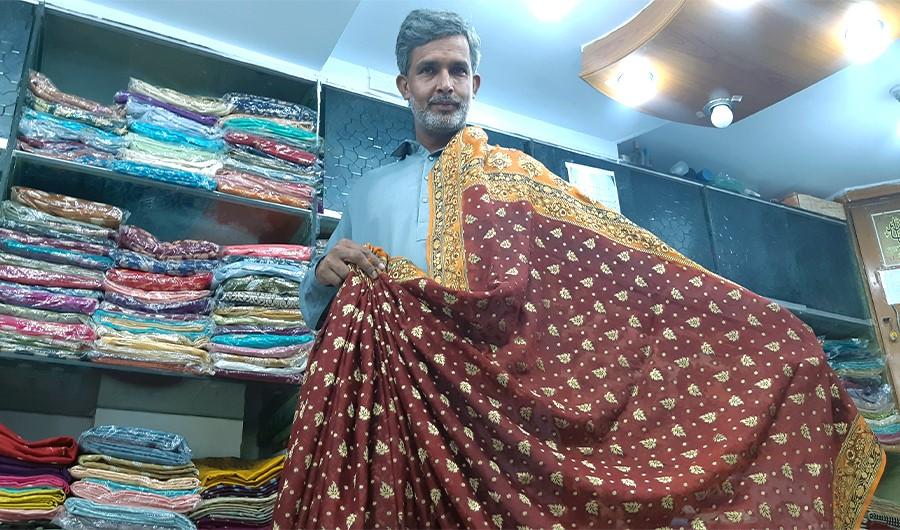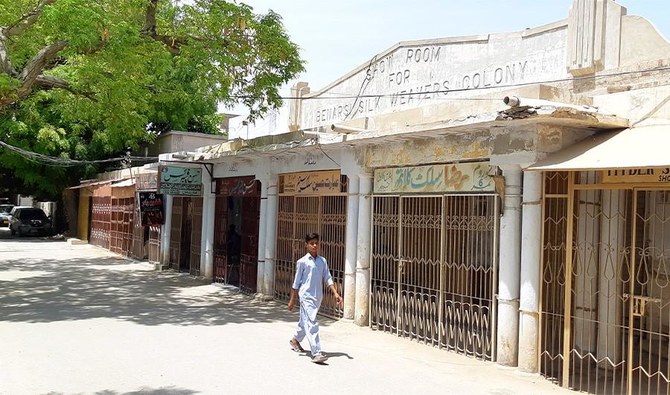SINDH: At the Banarsi Silk Weavers’ Colony in the city of Khairpur, in Sindh, 47-year-old merchant Zafar Abbas Ansari was waiting, hoping for a few additional orders of silk Banarsi saris as Eid Al-Fitr approached.
The sari is a garment native to South Asia, where a long piece of cloth is wrapped elaborately around the body — usually in cotton or silk — and worn with a matching blouse.
Although the city does not make Banarsi any longer — it is now made in Karachi, more than 400 km away — customers still come to the city to purchase the fabric.
Inside the deserted 70-year-old market — once a bustling place — Zafar’s shop is among the last three Banarsi shops left. His family is one of the 40 weaver families who brought the industry to Khairpur when they migrated from India in 1952.
“It is almost two decades since Khairpur stopped producing Banarsi saris after the industry’s collapse. However, even today, the brand is popular among customers. They keep demanding Khairpur’s brand,” Zafar told Arab News.
In its heyday, Khairpur’s Banarsi sari was synonymous with luxury, with vendors supplying the fabric not only locally but also exporting to Pakistani families living in the UK and other European countries.
Inside Zafar’s shop, unstitched pieces of colorful saris — the blouse, the petticoat and main sari fabric — are displayed. The shop shows off different varieties of saris, including the traditional katan — a plain woven fabric with pure silk threads — chiffon, as well as synthetic fabrics.
“Banarsi sari has distinction and standing,” Zafar said proudly. “It is worn by royal families because of its grace and elegance. In some families it is an essential part of the bridal trousseau.”

The price of a sari depends upon its type. The most expensive sari fabric available in the Khairpur market currently is worth Rs45,000 ($300) a piece
Khairpur’s Banarsi Silk Weavers’ Colony is named after the city of Banaras in India (now Varanasi) because of the silk weavers who migrated from there.
There are no official records, and the story of the garment comes from the weavers themselves. They say the history of the Banaras sari industry in Khairpur is linked with Ghulam Saddiquah Begum — the wife of Khairpur state’s then ruler, Mir Ali Murad Khan Talpur of the Talpur dynasty.
Saddiquah Begum herself came from Bahawalpur state, and in 1949, the weavers said, during a visit to India’s Hyderabad Deccan, she offered Mohammed Yusuf Ansari — a sari trader from Banaras — the chance to start manufacturing in Khairpur.
She is said to have offered her state’s support for the establishment of the manufacturing units required.
In 1952, about 40 families of the Ansari clan migrated from Banaras to Khairpur and sari manufacturing began on handlooms. Later, the saris were exported to other countries.
Arab News could not independently verify this information.
According to Anjum Sajjad Ansari, grandson of Muhammad Yusuf Ansari and a representative of the Banarsi Silk Weavers’ Association Khairpur, at its peak there were 400 handlooms in Khairpur. Today, not a single handloom remains.
“At Khairpur’s Banarsi Silk Weavers Colony today there are 16 houses of traditional weavers. However only three are involved in this business of selling Karachi-made fabric,” Anjum said.
Like elsewhere, the Banarsi brand was associated with pure silk thread work. Initially, Khairpur used silk imported from China, but later the silk came from Punjab’s Changa Manga as Pakistan developed hatching silkworms and silk fiber producing factories.
The whole family engaged in the manufacturing process, including silk weaving, dyeing, warping, and reeling. It took between two to three days’ work to complete a single sari.
The silk weaving industry was thriving into the 1960s.
“In 1965, Pakistan’s President Ayub Khan visited and gave incentives and subsidies that boosted the industry,” said Anjum.
“However, in the later years successive governments paid little heed to this industry, and manufacturing units were shifted to Karachi by 2000,” he said.
For Anjum, there is still a chance to revive the past glory of Khairpur.
“We have given proposals to the government at different forums. But nothing has been done yet. The Banarsi sari has become a trademark for Khairpur,” he said.
“Khairpur’s distinction was to produce only handmade silk fabric, unlike other areas where machines are involved. If the government is sincere, factories could be re-established and skilled laborers could be recalled once more from Karachi.”























